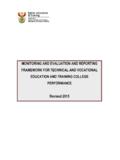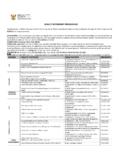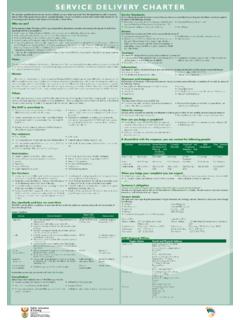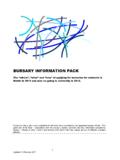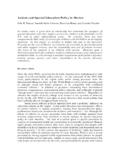Transcription of Sol Plaatje House 123 Schoeman Street Pretoria …
1 Department of education Sol Plaatje House 123 schoeman street pretoria south Africa0002 Private Bag X895 Pretoria 0001 Tel: +27 12 312 5911 Fax: +27 12 321 Department of education This publication is an internal document of the Department of education . It may be used in partor as a whole, provided that the Department of education is acknowledged as the source : Design and layout: Formeset Digital, Tshwane, (012) 324 0607 Printed by Formeset Printers CapeTable of 11. Introduction and 22. 23. Policy 34. Scope of 45. Status of the 46. Challenges faced in relation to 67. Priorities of the 78.
2 Department of education process/cycle of skills 89. 1010. Roles and 1011. 14 List of 15 Contact 19 1 Foreword by the Director-GeneralIt gives me great pleasure to publish this National Skills Development Frameworkwhich will facilitate the provision of the skills base required for the achievement of thestrategic objectives of Department of education . The National Skills DevelopmentFramework targets the development of all employees and future employees in publiceducation. This Framework is borne out of a concerted effort by all the relevant role-players to ensure that we deliver efficiently and effectively on our objective toimprove the quality of publication would not have been possible without the contribution of officials ofthe Provincial Departments of education and the ETDP SETA.
3 We remain profoundlyindebted to other partners in the education , training and development sector, whose ongoing support and recommendations will provide the basis for the furtherdevelopment and improvement of our educators and a key player in supplying skills and competencies to the country the Department ofEducation is facing up to the challenge of responding to Provincial Growth andDevelopment Strategies and to contribute to the Accelerated and Shared GrowthInitiative for south africa (ASGISA).Duncan HindleDirector-General2 National Skills Development Framework1. Introduction and backgroundThe aim of the National Skills Development Framework is to facilitate, monitorand coordinate Skills Development activities within the Department of education .
4 For purposes of this National Skills Development Framework, we define thenational Department of education and the nine Provincial Departments ofEducation as the Department of education . In terms of this Framework, skills development refers to education , training anddevelopment activities designed to help employees and future employees gainknowledge, skills and attitudes that would improve their performance in the positions that they currently hold and improve their future the past, the Department of education conducted training and skills development in the absence of a coordinated and coherent National SkillsDevelopment Framework.
5 This resulted in a fragmented, uncoordinated, andhaphazard approach to skills development interventions. This National SkillsDevelopment Framework intends to address this problem. The Framework wasdeveloped in collaboration with the relevant stakeholders. 2. PurposeThe purpose of this framework is to facilitate the provision of the skills base that is required for the achievement of the Departments' strategic objectives and the development of all employees and future cognisance of the provisions of the relevant policy directives, this Frameworkis geared towards:3 Inculcating a spirit of lifelong learning among employees of the Departmentof education .
6 Ensuring equitable access to and participation in properly structured education , training, and development interventions that will lead to theacquisition of competencies that will enable employees and future employees of the Department to enhance their job or work performance,thus resulting in improved service delivery. Providing specific guidelines with respect to skills development programmes and initiatives that the Department will implement. Linking strategic Departmental education , training, and development initiatives with National Skills Development Strategy outcomes. Providing for a standardised approach to the implementation of skills development programmes within the Department.
7 Ensuring that the Departments budget spend at least a minimum of onepercent (1%) of their personnel payrolls for skills development. Monitoring and evaluating the implementation of skills development inDepartments. 3. Policy environmentThe Skills Development Framework is guided by the fact that the south Africanworkforce, in this case all employees within the education training and development sector, need relevant and competitive skills. These are required inorder for them to develop as individuals, to add value to the performance of theorganisation, and for them to contribute meaningfully to the development of theSouth African economy.
8 The following policies and legislative frameworks are inplace to help ensure that these goals are realised: Skills Development Act of 1998 Employment Equity Act of 1998 Skills Development Levy Act of 1999 Labour Relations Act of 19954 Public Service Act of 1994 Employment of Educators Act 1998 National Skills Development Strategy (NSDS 2005-2010) National HRD Strategy for south africa 2001 Integrated Quality Management System 2003 National Framework for Teacher education (Draft)4. Scope of applicabilityThis Framework applies to all areas of skills development within the Departmentof education . The Framework provides for a focus on the following categories ofemployees and future employees within the Departments of education : Institution-based educators Office-based educators Public servants (all levels) Applicants and potential applicants for Departmental posts 5.
9 Status of the SectorAccording to the Sector Skills Plan developed by the education , Training andDevelopment Practices Sector education and Training Authority (ETDP SETA) in2004, there are 56 754 institutions in the education , Training and Development(ETD) Sector. These institutions employ an estimated 656 068 people, and theDepartment of education 's headquarters and provincial offices employ a further10% of all the employees in the sector. In relation to total employment ( million people employed in the formal sector of the economy), this sub sector ofthe south African economy employs six percent (6%) of all employees in SouthAfrica.
10 Furthermore, the ETD sector provides job opportunities to a third of allemployees in the community, social and personal services a fifth (17%) of all employees in the sector hold managerial positions. 5 The rest of the sector is composed mainly of educators (70%), while 5% are administrative staff and 8% are support staff. The demographic profile ofemployees in public ETD sector particularly that of teaching staff membersreflects the national distribution in general: 78% of employees are African, 11%are White, eight percent (8%) are Coloured, and three percent (3%) are are under represented in the education Training and Development sector ingeneral, with only a third of all employees being expenditure on education , which covers staff salaries, administration, infrastructure, learning support materials and other expenses, provides an indication of the size of the education sector as a whole.


